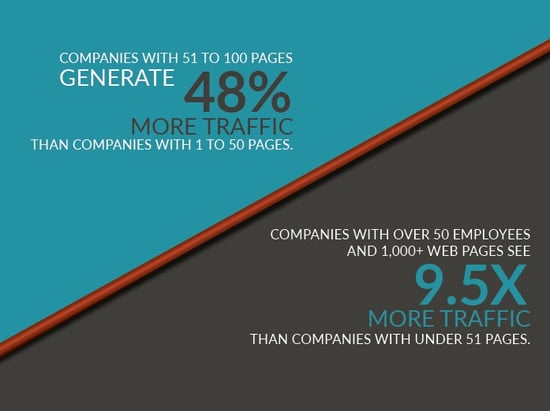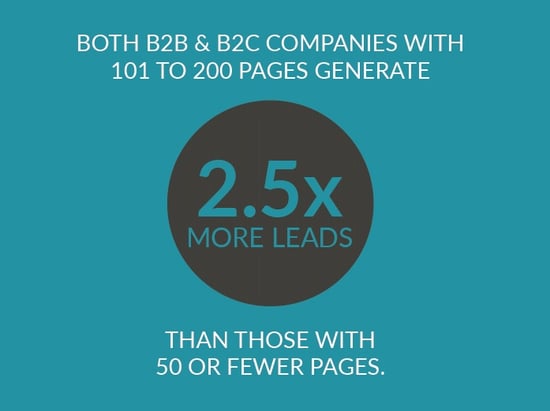How Business Blogging Drives Website Growth (Or What We Love About Business Blogs)

One of the key tools at the heart of successful inbound marketing is the business blog.
Business blogging provides content to reach prospects, leads and customers with information they want and need. It establishes your position as a leader in your industry. And it links readers to the offers that convert them into leads.
But it has even more specific, measurable impacts on these metrics that indicate your website’s effectiveness, as shown in these Marketing Benchmarks of 7,000+ Businesses.
More Website Pages = More Website Traffic and More Leads
In its study of more than 7,000 of its customers, HubSpot found that the number of pages on a website has a profound effect on the amount of traffic it generates.
While the biggest boost occurs when company websites top 1,000 pages, even the increase from fewer than 50 pages to 51-100 pages has an impact.

Similarly, sites with more pages typically correspond with greater online lead generation. The highest level of inbound leads comes to B2C companies with more than a thousand website pages.
Does a thousand pages sound unrealistic? If you are a B2B brand, and don’t rely on ecommerce with hundreds of product pages, it might be. But could you create more than 200 pages on your site?

So, how do you get all those pages if you aren’t focusing on e-commerce or individual products?
More Blog Posts = More Website Pages
The answer: Blogging.
Each individual blog post is a page of its own. That means that if you are blogging once a week, within a year you will have added more than 50 pages to your site through blogging alone.
Of course, for blogging to be effective as a lead generation tool, it needs to be sending readers to offers than convert them into leads. Each of those offers has its own landing page - more pages on your site to attract traffic and boost lead generation potential.
Why Blogging More Frequently Matters
Of course, you can increase the number of pages on your site more quickly by blogging more frequently.
HubSpot has found that its users start to truly see the impacts of blog creation most when they have amassed a blog inventory of 120 posts. Obviously, you may not want to wait more than two years to see those website traffic and lead generation results, so blogging more than once a week just makes sense.
In fact, companies that published 16 or more blog posts per month (that’s 4 times a week) got almost 3.5 times more traffic than companies that published 0-4 monthly posts.
There are some differences depending on the type of business you operate. Blogging’s impacts are even larger for B2C companies than they are for B2B, though neither should be overlooked.
- B2C companies that blogged 11+ times per month got more than 4X as many leads than those that blog only 4-5 times per month.
- B2B companies that blogged 11+ times per month had almost 3X more traffic than those blogging 0-1 times per month.
Traffic is great, but what you really want from your business blogging efforts are leads, right?
Blogging frequently pays off there, too. Companies that published 16 or more blog posts per month got about 4.5 times more leads than companies that published 4 or fewer monthly posts.
(Find all of these statistics and more here.)
Now you know why we believe in blogging on a steady basis, 5 days a week, with a variety of content, topics, and formats to provide marketers, public relations pros, and other business professionals with the information they need to maximize their inbound marketing efforts.
Is it easy? No. But it is worth it.
Here are a few steps that will make blogging easier for you and your staff.
Plan a year’s worth of campaigns to provide focus for your business blog: Campaign Planning Calendar.
Schedule blog posts and creation duties—topics, audiences, author, due date and publication date: Blog Calendar Template.
Give your writers resources to help them create quality blog content: 5 Ways to Write A Business Blog (templates); Blog Essentials Checklist; and Content Quality Report Card.
What other resources do you need in order to make the most of your business blog’s potential?
-1.png?width=1652&height=294&name=Jones(RGB)-1.png)












